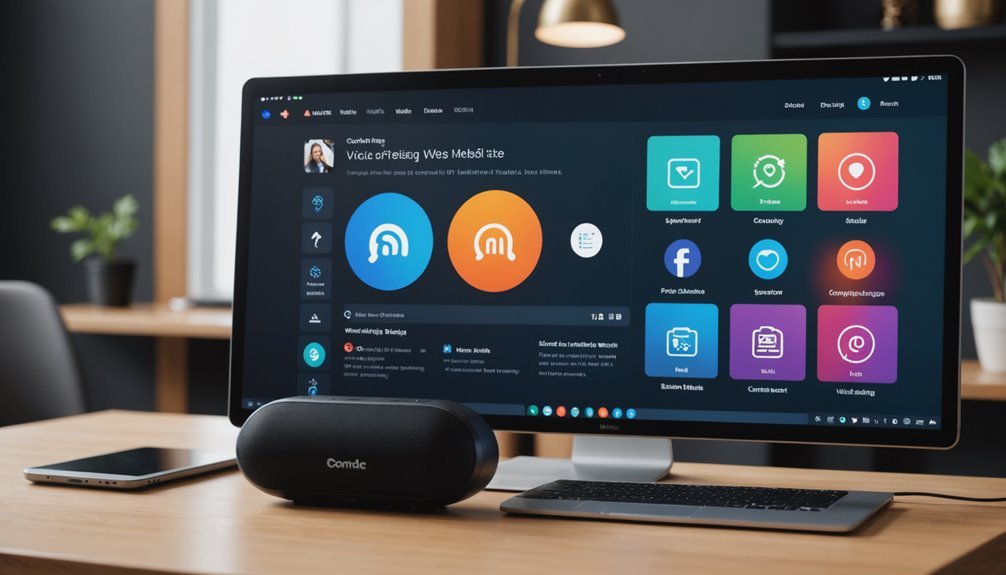Voice-friendly website design refers to integrating intuitive navigation, responsive voice interactions, and adaptive user responses into website interfaces. This creative design approach utilizes advanced technologies like Natural Language Processing (NLP) and speech recognition to improve user experience and foster engagement. It also optimizes websites for voice searches, increasing their visibility to voice-activated queries. Implementing a voice-friendly design not only enhances website accessibility but also offers advantages in market competitiveness and regulatory compliance.
Further exploration of this topic will provide a wealth of knowledge on practical strategies and benefits of optimizing websites for voice interactions.
Key Takeaways
- The voice-friendly design emphasizes intuitive navigation and minimalistic voice commands.
- Conversational keyword strategy and natural speech patterns enhance visibility in voice searches.
- Voice technology improves accessibility, allows hands-free interaction, and boosts user engagement.
- Integrating voice in web services transforms user interactions, leveraging technologies like speech recognition and Natural Language Processing.
- Continuous improvement and optimization strategies, including regular testing and refinement of voice functionalities, are crucial.
Key Principles for Voice-Friendly Design
In modern web design, the principles for designing voice-friendly websites are becoming increasingly crucial to understand and implement. A critical element involves creating a simple and intuitive design. This includes using clear, concise language in voice interactions, guaranteeing logical navigation, and maintaining minimalistic voice commands. Immediate and direct feedback after each interaction is also paramount, as is achieving a thorough understanding of the user’s context to provide individualized responses.
Effective integration of voice commands is another key aspect. Conducting user research to comprehend specific needs and expectations, defining voice interactions, and developing a robust architecture capable of processing natural language are essential steps in this process. Regular testing and refining of voice functionalities, focusing on conversational long-tail keywords, can additionally improve user engagement. The utilization of advanced AI-driven solutions for voice recognition can significantly enhance the user experience and lead to more successful interactions (AI-driven solutions).
Efficient voice search optimization is critical, and it can be achieved through a conversational keyword strategy, direct answers, local search optimization, quick page load speed, and voice-assistant-friendly content structure. Moreover, technical considerations such as backend integration, robust testing, performance optimization, intuitive voice user interface design, and continuous iteration are required to guarantee seamless voice interactions, responsive user experience, and brand alignment.
Furthermore, considering the growing popularity of voice technology, it’s essential to monitor trends and stay updated on the latest advancements in voice recognition tools, including AI-driven solutions, to continue enhancing voice integration strategies (monitor trends).
Benefits of Voice in Web Design
Voice technology is revolutionizing web design with a host of benefits that are transforming the user experience, accessibility, and market dynamics. Voice technology improves accessibility by giving visually impaired users the freedom to navigate websites independently, fostering inclusivity. It also facilitates hands-free interaction, which is a boon for people with limited mobility.
Voice commands offer undeniable efficiency and convenience. They enable users to access information and services more quickly, enabling multitasking and increased productivity. They also simplify interactions, reduce user fatigue, and expedite tasks, aligning with the desire for convenience and ease of use. Furthermore, this technology streamlines operations efficiently, making it a valuable asset for businesses.
Voice technology also boosts user engagement and satisfaction. It offers an interactive, customized experience that reduces bounce rates and improves overall satisfaction. Additionally, this technology provides significant market advantages. Voice-activated websites attract a wider audience, allowing businesses to stay ahead in a competitive landscape. By optimizing for voice search, websites can increase their visibility and traffic. As the future of web design is heavily influenced by voice technology, its integration is vital for future business success.
Moreover, the use of voice technology in web development is not just restricted to user interaction; it’s also transforming the way developers work. With the help of voice-activated virtual assistants, developers can automate repetitive tasks, enhancing their focus on critical aspects of website development and ultimately boosting productivity automate repetitive tasks.
Designing Effective Voice User Interfaces

Designing an effective Voice User Interface (VUI) requires a keen understanding of its two critical aspects: mimicking natural speech and creating context. The former involves optimizing the interface to comprehend and respond in a manner that mirrors individual conversation, thereby enhancing user engagement. Meanwhile, creating context is about ensuring the VUI can maintain the continuity of a conversation, enabling it to focus on user requirements and provide relevant responses.
Additionally, a vital aspect of a successful VUI design is the incorporation of clear indicators for system status, such as when it is listening, processing, or responding, contributing to a more user-friendly and intuitive interaction (clear indicators for system status). AI tools can significantly enhance the design process, offering data-driven insights that can inform the creation of more effective and engaging VUIs.
Mimicking Natural Speech
To effectively mimic natural speech in voice user interface (VUI) design, a nuanced understanding of both personal communication and advanced technology is required. This involves using Natural Language Processing (NLP) to interpret user intent, ensuring context awareness throughout interactions, and processing colloquialisms and linguistic nuances. It’s essential to contemplate the variety in speech patterns and develop adaptive responses that cater to the user’s environment and situation.
The design principles for mimicking natural speech emphasize user-centric interaction models, clear and concise prompts, and natural voice commands. Error recovery and progressive disclosure are also significant elements in ensuring an intuitive and user-friendly experience. An essential aspect of this process is to establish a unique VUI persona that aligns with the brand identity, thereby enhancing user relatability and engagement (VUI personality). Implementing effective repeat business strategies can also be beneficial in maintaining user engagement and fostering loyalty.
Advanced text-to-speech (TTS) engines, cloud infrastructure, and AI-powered optimization are some of the technical considerations for mimicking natural speech. These technologies facilitate multimodal integration and maintain multimodality for authentic-time interactions.
| Key Strategies | Design Principles | Technical Considerations |
|---|---|---|
| Natural Language Processing | Natural Voice Commands | Speech Synthesis |
| Context Awareness | Clear and Concise Prompts | Cloud-Based Interaction |
| Adaptive Responses | Error Recovery | Machine Learning |
A successful VUI design that mimics natural speech requires continuous refinement based on user testing, iterative improvement, and effective management of long-term context.
Creating Context and Focus
Creating context and focus is paramount when crafting a voice user interface (VUI). This component boosts user experience and contributes to the success of the complete design. A well-designed VUI should demonstrate an understanding of the user’s context and adapt accordingly.
To attain an effective VUI, consider the following steps:
- Identify User Context: Recognize different user environments and situations. Adjust voice recognition sensitivity and provide visual feedback in noisy environments. An automated system, like sales automation tools, can also predict and adapt to user behavior efficiently.
- Design for Flexibility: The VUI should be adaptable enough to handle varied user inputs and scenarios, such as interruptions or multitasking. Adequate error handling and mobile optimization are key.
- Create a Consistent Persona: A distinctive, brand-aligned persona that meets user expectations improves user experience. It should reflect friendly, helpful, and engaging traits.
- Manage Tasks Efficiently: Break down complex tasks into simple steps using clear, concise language. Minimize steps required for task completion, provide clear instructions, and guarantee efficient navigation between functions. It is also important to note that the integration of key components like speech recognition and Natural Language Processing (NLP) is crucial for an optimal user experience integration of key elements.
Optimizing Websites for Voice Search
Given the rapid growth and wide acceptance of voice search technology, optimizing websites for voice search has become a vital component of effective online marketing. As per usage statistics, over half of all adults use voice search daily, highlighting its importance in the current digital environment.
One of the most effective ways to optimize a website for voice search is through schema markup or structured data. This helps search engines understand web page content, increasing the likelihood of being featured in voice search results. Similarly, using long-tail keywords and conversational language improves voice search visibility, as this mimics the natural language used in voice queries.
Moreover, the incorporation of Natural Language Processing (NLP) techniques in content creation aids in recognizing popular speech patterns, thereby aligning your website better with voice search queries (NLP techniques). AI and automation tools, such as chatbots and predictive analytics, can also play a significant role in optimizing voice search by improving response times and personalizing customer interactions (AI and automation tools).
Mobile optimization is another key factor, given the significant percentage of voice searches conducted on mobile devices. A mobile-friendly design improves user experience and boosts search engine rankings, thereby increasing the chances of content being read aloud by voice assistants.
Lastly, SEO remains essential in this situation. Effective SEO techniques improve loading speeds and general user experience and increase visibility in voice searches, with featured snippets playing a significant role in voice search results.
Voice-Friendly Content Strategies

Steering through the domain of “Voice-Friendly Content Strategies,” we must address the importance of concise content creation, utilizing bulleted lists, and consistent formatting. These components not only improve the user experience but also optimize the site’s interaction with voice-based technologies. Employing these strategies allows for a smoother, more responsive interaction between users and voice assistants, facilitating seamless content accessibility.
Additionally, a conversational tone is a vital aspect in creating voice-friendly content, as it mirrors the natural, spoken language of users (Natural, conversational tone). Meanwhile, implementing sales automation solutions can also help businesses handle missed calls efficiently, thus avoiding potential revenue loss and negative impact on their reputation (Sales automation solutions).
Concise Content Creation
In the domain of voice-friendly website design, the importance of concise content creation cannot be overstated. As we welcome the era of voice technology, content must be designed to cater to voice search users who want quick and direct answers.
A successful strategy for concise content creation involves the following steps:
- *Focus on Conversational Phrases*: Use long-tail keywords that mimic natural speech patterns. This approach increases relevance in voice searches, which are often conversational.
- *Direct and Concise Answers*: Provide clear, succinct responses to queries. The aim is to offer thorough solutions without overwhelming the user with excessive information.
- *Conversational Tone*: The tone of the content must mirror natural speech. This strategy improves the user experience by making the interaction feel more individual and less robotic.
- *Improving Page Load Speed*: Quick page load times are vital in voice search, as users typically expect immediate responses.
Achieving concise content creation fosters user-friendly, voice-optimized websites that deliver information efficiently, embodying the freedom that today’s tech-savvy audience desires.
Utilizing Bulleted Lists
Often underestimated, the use of bulleted lists is a powerful technique for voice-friendly content strategies. Bulleted lists can remarkably improve the accessibility and readability of your content, especially for users of screen readers. It’s vital to employ correct HTML list elements such as ‘
- ‘ to establish a clear list structure. This approach enables screen readers to accurately identify and announce list elements, providing a seamless user experience. A golden rule to remember when employing bulleted lists is brevity. Ideally, keeping each list item concise, with no more than two sentences, facilitates quick scanning and skipping, improving the complete user experience. This method also minimizes user distraction and increases information retention. When it comes to list behavior, it is necessary to confirm that lists are readable and skippable in screen readers. Properly structuring the list with HTML elements can achieve this, as screen readers can announce the number of items. Lastly, consistency cannot be overstated. Use parallel sentence construction for list items, maintain consistent punctuation, and use consistent list symbols throughout your website. These practices improve readability and maintain visual cohesion, contributing to a more engaging, user-friendly website.
Consistent Formatting Importance
Maintaining consistency in formatting is a cornerstone of effective voice-friendly content strategies. In the digital era, users demand seamless, frictionless experiences and appreciate predictability. Consequently, formatting consistency plays a critical role in improving user experience and maximizing engagement.
- Consistent Visual Elements: Consistency in visual elements like color schemes, typography, and imagery aligns with the brand’s voice, promotes the brand identity, and creates heartfelt connections. Regular updates are necessary to maintain this alignment.
- Structured Content: Logical organization and consistent formatting create a predictable and easy-to-scan content structure. Layering content and progressively disclosing information further improve user experience.
- Consistent Tone and Style: Maintaining a consistent tone and style builds genuine connections and fosters trust, contributing to brand awareness. Long-term relationships with quality content providers are key to maintaining this consistency.
- Accessibility and Readability: A structured hierarchy with clear headings, content chunking, and adherence to accessibility standards guarantee inclusivity and optimize the user experience.
Integration of Voice in Web Services
The integration of voice in web services has transformed how users interact with websites, creating a more engaging and user-friendly experience. The core technologies behind this revolution include speech recognition, natural language processing (NLP), text-to-speech (TTS), and the Web Speech API, all accessible via JavaScript.
Successful integration requires a well-defined scope, selection of appropriate VUI platforms, thoughtful design of voice interactions, and meticulous development and integration of VUI. It is also essential to guarantee robust security measures to safeguard user data.
Technical considerations include checking browser compatibility with the Web Speech API, integrating with web and mobile apps using SIP protocol and WebRTC, leveraging external solutions like Voxpow, optimizing resource use, and allowing for voice command personalization.
To enhance the benefits of voice integration, website design should follow best practices such as maintaining simple layouts, ensuring responsive design, optimizing page speed, creating detailed FAQ pages with schema markup, and incorporating question words in content and headers for better voice search optimization. This approach offers users a genuinely liberating experience as they navigate the web.
Hands-Free Interaction Advantages

In web design, the advantages of hands-free interaction have become increasingly evident. By using voice commands to navigate and control websites, users are granted a new level of freedom and accessibility, enhancing productivity and user experience.
There are several key benefits attributed to this groundbreaking form of interaction:
- Reduced Physical Effort: Voice interaction eliminates the necessity of physical input, simplifies tasks, and reduces fatigue. This is particularly beneficial for people with mobility impairments and the general public, as it allows for comfortable multitasking.
- Enhanced User Experience: Natural language processing facilitates intuitive, conversational interaction, which results in efficient information retrieval and a reduced cognitive load on users.
- Expanded User Capabilities: Hands-free control facilitates interactions and advances multimodality. Voice commands allow users to accomplish tasks faster and more efficiently.
- Future Design Considerations: Emphasizing conversational design, linear content structure, and intuitive feedback can significantly improve the user experience.
Indeed, hands-free interaction has great potential to transform web design and change how users interact with digital platforms.
Voice and Enhanced Accessibility
The integration of voice technology in website design offers unmatched benefits, especially in enhancing accessibility for persons with disabilities. It provides a new dimension to user experience, combining inventive technology with user-centered design principles for a more inclusive online environment. From practical implementation considerations to aligning with accessibility guidelines, this subtopic will examine the multifaceted aspects of voice-driven user experience and how it shapes accessible web design.
Voice Interaction Benefits
When voice interaction is integrated into website design, steering through a virtual environment becomes notably easier. This not only simplifies navigation but also improves accessibility, making online content more inclusive.
- Simplifies Navigation: Voice interaction negates the need for physical input, enabling more effortless access to online content.
- It assists users with visual impairments by allowing them to interact with websites without reliance on visual cues or aids.
- Supports Motor Disabilities: Voice interaction alleviates physical strain by reducing the necessity for precise mouse movements or keyboard inputs.
- Intuitive Interaction: Users can perform tasks via natural language, making the interaction with the website more intuitive and user-friendly.
Moreover, voice interaction dramatically improves efficiency by enabling users to perform actions via voice commands. This hands-free interaction is especially beneficial for users with limited mobility or those who multitask. By complying with accessibility regulations, voice interaction guarantees a more inclusive online environment, promising a broader range of users the freedom to navigate the online space effortlessly. Consequently, voice interaction is not just a design feature but an enabler of digital freedom.
Designing for Disability
Voice recognition technology breathes a new life into the domain of accessibility in web design, specifically for users with disabilities. It’s a groundbreaking solution that paves the way for hands-free navigation and voice command accessibility, thereby improving the web experience for those with motor impairments. It offers an alternative input method, fostering independence and autonomy. To guarantee usability, providing clear instructions for voice commands is indispensable.
Voice recognition has become a powerful tool for visually impaired users. It integrates with screen readers and other assistive technologies, offering an all-encompassing solution for content accessibility. It also enables voice navigation, providing contextual information to improve the user’s understanding of the website’s layout and content.
Voice recognition technology can simplify navigation, reduce cognitive load, and facilitate content processing for users with cognitive impairments. By chunking information and providing external lists and definitions for complex operations, it creates a more accessible digital environment.
Adherence to accessibility standards, such as WCAG 2.2, is vital. Integrating voice recognition technology not only guarantees legal compliance but also drives creativity in web design, promoting a more inclusive and user-centered approach. Consequently, voice recognition technology is a game-changer in designing for disability.
Voice-Driven User Experience
Building on the foundation of voice recognition technology for accessibility, we now investigate the Voice-Driven User Experience (Voice and Augmented Accessibility) sector. This exciting field allows users to interact with a website using voice commands, making the web a more inclusive space for all.
- Design Principles: Incorporating consistency, flexibility, efficiency, and scalability in voice commands and interactions is pivotal. It opens a new avenue for users, particularly those challenged by traditional forms of access.
- Voice Search Trends: With 4.2 billion voice assistants currently in use and expected to double by year-end, the voice search landscape is rapidly evolving. It offers fast, efficient, and localized results that cater to users’ distinct needs.
- User Engagement: Voice assistants are widely used across all generations, especially Millennials and Gen Z. They are increasingly used for local searches and shopping, highlighting the potential for businesses to tap into this market.
- Voice User Interface (VUI) Strategies: Detailed user research, thorough customer path mapping, and machine learning algorithms that learn from interactions are key strategies in crafting a voice-friendly user experience. Remember, freedom comes from personalization, so offering tailored VUI settings is a must.
Efficiency Through Voice Design

Utilizing the power of voice-friendly design can significantly improve a website’s efficiency. A logically structured navigation system with clear labels and a detailed sitemap guarantees that voice-assisted users can easily find what they’re looking for. An optimized URL structure aids in this process, making each page simple to locate and describe.
Content optimization is another vital component, necessitating the use of conversational language and long-tail keywords that align with natural speech patterns. By leveraging natural language processing algorithms, websites can comprehend user queries accurately, delivering a seamless and relevant user experience.
Performance improvement, including image compression, browser caching, and responsive design, guarantees websites load quickly and adapt to different screen sizes and devices. This is particularly significant for voice search users who expect immediate results.
Finally, the integration of voice search capabilities directly into the website interface, along with a mobile-first design approach, caters to the growing number of mobile device users. The inclusion of voice-activated search bars and commands further boosts user interaction, solidifying the significance of accessibility in efficient voice-friendly design.
Creating Context in Voice Interfaces
Understanding the user’s context is vital to creating effective voice interfaces. Contextual design enables voice interfaces to adapt to user needs across numerous scenarios, improving user freedom and experience.
Contextual elements to take into account include:
- Time of Day: The relevance of voice interactions fluctuates throughout the day. For instance, asking about the weather in the morning or music preferences in the evening can boost user engagement.
- Location: The user’s location, whether at home or office, affects the relevance of unique voice interactions.
- Previous Interactions: Leveraging past conversations can help provide a more tailored user experience.
- User Needs: Identifying user objectives and pain points is vital in crafting relevant conversation flows.
Moreover, designing for accessibility is critical. Incorporating visual cues, providing visual feedback, displaying conversation transcripts, and utilizing microphone icons can significantly improve user interactions. Finally, a thorough analysis of voice command structure, taking into account intent, utterance, slots, and alignment with context, can further refine voice interaction. User testing can validate the effectiveness of these strategies.
Voice Search Optimization Techniques

When examining voice Search Optimization Techniques, it is crucial to recognize their revolutionary role in enhancing digital interactions and streamlining the user experience. These techniques, an amalgamation of art and science, are crafted to accommodate a shift towards a more natural, conversational interaction with technology.
In the domain of content, keyword research is the foundation, focusing on long-tail keywords that mirror natural speech and using question keywords. Tools like SEMrush and Ahrefs provide invaluable insights into potential keywords and user intent.
Local SEO is the key to mobile optimization. Incorporating local keywords, practical information, and schema markup enhances visibility. Ensuring mobile-friendliness and utilizing location-based structured data is crucial for catering to on-the-go searches.
For featured snippets, clarity reigns supreme. Concise answers, structured content, and short responses optimize for position zero, improving voice search visibility.
Lastly, website performance cannot be overlooked. Fast-loading, mobile-first design sites using schema markup are preferred. Regular audits and content optimizations maintain visibility, thereby ensuring a voice-friendly website that offers users the freedom they desire.
Continuous Iteration for Voice Optimization
The continuous iteration for voice optimization is a dynamic process that demands vigilance and meticulousness. It is a cycle of constant improvement that evolves with changing user behaviors and search engine algorithms. Here are four key strategies for successful voice search optimization:
- Optimization for Featured Snippets: Create structured content in a question-and-answer format. Update your content regularly to maintain your position in featured snippets.
- Structured Data Implementation: Utilize schema markup to improve search engine understanding of your content. Regular audits can guarantee consistency and accuracy.
- Long-Tail Keyword and Content Refinement: Utilize tools like AnswerThePublic to identify conversational search terms. FAQs and question-and-answer formats are recommended. Keep your content precise and clear.
- Mobile and Speed Optimization: Make sure your website is mobile-friendly and loads quickly. Regular speed and mobile usability tests can help maintain performance.
Remember: Freedom in voice search optimization comes from continuous refinement, regular audits, and consistent updates. Stay on top of your game to make sure your website maintains its voice search optimization.
Frequently Asked Questions
What Are Some Challenges in Implementing Voice Technology on Websites?
Implementing voice technology on websites poses challenges that include ensuring data security, maintaining compliance, handling integration complexities, overcoming linguistic limitations, adapting design, and optimizing for conversational queries while dealing with evolving algorithms and complex performance tracking.
How Do Voice Interfaces Protect User Privacy and Data Security?
Voice interfaces protect user privacy and data security through robust encryption protocols, secure transmission methods, strict access controls, data minimization strategies, and regular compliance audits, ensuring stringent safeguards against unauthorized access and data breaches.
Can Voice Interfaces Be Integrated With Other Emerging Technologies Like Ar/Vr?
Yes, voice interfaces can be integrated with emerging technologies like AR/VR. This requires careful design considerations and the use of popular AR platforms. Voice interfaces improve user experience through natural interaction and customization and have applications in multiple sectors.
How Does Voice Technology Impact Website Design Aesthetics and Visuals?
Voice technology markedly transforms website aesthetics and visuals, emphasizing natural language processing, supporting hands-free experiences, and enhancing accessibility. It necessitates a shift towards more conversational content and redesigned interfaces for voice-activated functionalities.
What Are the Costs Associated With Incorporating Voice Functionality Into a Website?
Incorporating voice functionality into a website involves costs for voice search optimization, integration, and possible design adjustments. The costs vary depending on the strategy’s complexity, site size, and the type of voice interface implemented.
Conclusion
To summarize, the incorporation of voice-friendly design into website development is a significant trend in the online environment. According to ComScore, by 2020, 50% of all online searches will be conducted via voice. This indicates a transformation in user interaction, underscoring the necessity for designers to optimize websites for voice search and implement effective voice user interfaces. Continuous voice optimization will guarantee improved user experience and increased efficiency in online interactions.

Erik Remmel is a co-founder of Launched, a platform that helps businesses grow through AI-powered marketing, automation, and lead generation. He focuses on building scalable systems that convert cold leads into customers while streamlining operations with smart, AI-driven workflows.




